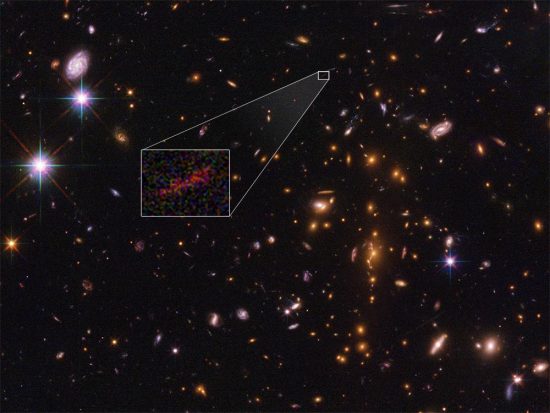
Jan 17, 2019
Can strong gravity bend space?
Einstein’s theory of General Relativity states that, when light passes close to a massive celestial object it bends in the same way that light is refracted by a glass lens. In consensus circles, that phenomenon is labeled “gravitational lensing”. As the theory states, if an object is massive enough, and another more distant object is aligned behind the first object along its line of sight, gravity bends the light of the far object into multiple images, or “smears” the more distant observation.
According to a recent press release, the Hubble Space Telescope detected what astronomers call the “….farthest galaxy yet seen in an image that has been stretched and amplified by a phenomenon called gravitational lensing.” SPT0615-JD is so far away that it appears as it was when the Universe was only 500 million years old. A foreground galaxy cluster, SPT-CL J0615-5746, is said to not only boost the distant galaxy’s light, but stretch it into an arc.
There are many problems inherent in gravitational lensing theory. First, mass distribution and luminosity of the foreground cluster means that there ought to be a blurred ring around it and not a smeared out arc. Also, gravitational lensing depends on mass effects, but galaxies are composed of plasmas. Since plasma is electrically charged, and electricity exerts forces that are orders of magnitude greater than gravity, phenomena that depend on the influence of an undetectable mass of dark matter for power require a small amount of plasma for the same results.
Conventional theories allow space and time to act like things that can be manipulated by gravity. As if space and time are malleable. The entire premise, and the associated theories about expansion and the Big Bang, depends on a single assumption, that higher redshift equals greater distance.
The Universe is 99% charged matter in the plasma state, so “luminous matter” is sufficiently powerful to account for whatever is happening in space. That so-called 4% of “baryonic matter” is what is actually observed. It is an intriguing convergence that the amount of gravitational mass invented to save conventional theories is the same as the ionized plasma that is overlooked.
Retired Professor of Electrical Engineering, Dr. Donald Scott points out that it is more likely that the “smeared” galaxy is a plasma discharge effect similar to what is seen in planetary nebulae. The smeared galaxy could be a plasma focus discharge viewed from the side.
Stephen Smith












